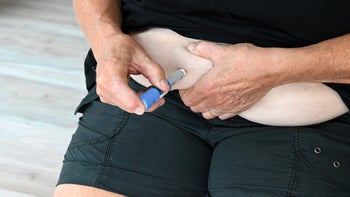
How to Inject Ozempic: 5 Pharmacist-Backed Tips for Best Results
Key takeaways:
Ozempic (semaglutide) is a once-weekly injection that treats Type 2 diabetes in adults. It comes as an injection pen. You’ll inject a dose once a week subcutaneously (under the skin) into the stomach, thigh, or upper arm.
It’s best to inject Ozempic on the same day each week. You can inject your dose at any time of the day, with or without food. And you don’t need to separate your Ozempic dose from your other medications.
There are many ways to save on Ozempic. If you’re eligible, a manufacturer savings card can help you access Ozempic for as little as $25. A patient assistance program is also available.
Access savings on related medications
Table of contents

Managing Type 2 diabetes can sometimes feel overwhelming. Fortunately, medications like Ozempic (semaglutide), which comes as a convenient once-weekly injection, can help you achieve your treatment goals.
But if the idea of giving yourself a shot feels intimidating, you’re not alone. The good news is that Ozempic comes as an injection pen that’s easy to use. And with a little guidance and practice, you can quickly build the confidence to administer it yourself with ease.
Your healthcare team will walk you through how to inject Ozempic correctly. But if you still have questions, we’ve got you covered. Let’s review five pharmacist-backed tips to help you get the most out of your Ozempic prescription.
Save every month on GLP-1 meds with GoodRx
Save an average of $235 on FDA-approved GLP-1s like Ozempic and Zepbound.

1. How to inject Ozempic
If you’re not sure how to use your Ozempic pen, your prescriber or pharmacist can help. But here are a few basic steps to follow when injecting Ozempic.
Pick your injection site. You can inject Ozempic subcutaneously (under the skin) into one of three places: the stomach (at least 2 inches from your belly button), front of either thigh, or upper arm. You can inject Ozempic yourself. But if you pick your upper arm, it’s best to have someone else help you with the injection. Choose a different injection spot with each dose.
Gather your supplies. If you’re planning to use a new Ozempic pen, remove it from the refrigerator about 30 minutes before your dose. This can help the injection be more comfortable. Grab a new disposable pen needle, alcohol swabs, and a sharps container. Once you have your supplies, wash and dry your hands.
Attach a new needle. Remove the pen cap. Tear the paper tab off the new needle, push the needle onto the pen, then turn until it’s tight. Pull off the outer and inner needle caps. Don’t reuse needles. Otherwise, the needle could become blocked or contaminated.
Select your dose. If you’re using a new Ozempic pen, your healthcare team will show you how to prime your pen. When you’re ready to select your dose, turn the dose selector. Stop turning once your dose shows in the dose counter and lines up with the dose pointer.
Clean the injection site. Clean the injection site with an alcohol swab and allow it to dry prior to injecting.
Inject Ozempic. Insert the needle into your skin, then push and hold down the dose button. Once the dose counter shows “0” and lines up with the pointer, count for 6 seconds before releasing the button and removing the needle from your skin.
Throw away the used needle. Carefully remove the needle from the pen and place it into a sharps container. Put the cap back on your Ozempic pen if it still has doses left. Otherwise, throw the used Ozempic pen into the sharps container.
2. You can inject Ozempic at any time of day, but stick with the same day each week
There’s no best time to inject Ozempic. But you should inject Ozempic once a week on the same day of the week, every week. It doesn’t matter whether you inject Ozempic in the morning or at night.



It’s possible to change the day of the week you inject Ozempic. The general rule is to avoid administering two doses that are less than 2 days apart. But it’s best to talk with your prescriber or pharmacist first. They can help you switch your injection day safely.
3. You don’t need to separate Ozempic from when you take other medications
Ozempic can have drug interactions. But this doesn’t mean you need to administer your Ozempic dose at a different time than your other medications. In most cases, you can give yourself your Ozempic injection at the same time as your other medications.
This includes other injectable diabetes medications, such as insulin, which you may be prescribed along with Ozempic. You can inject Ozempic and insulin in the same general body area (such as the stomach). And you don’t need to wait a certain amount of time between injections. But don’t inject them in the exact same spot or right next to each other. Give each injection separately — don’t try to mix them together.
Ozempic interactions can also occur with certain oral diabetes medications, putting you at greater risk of low blood glucose (hypoglycemia). Your prescriber may adjust the dose(s) of your diabetes medications in some cases.
Additionally, it’s possible that Ozempic could affect how certain oral medications are absorbed. This is because Ozempic slows down how fast your stomach empties. Your prescriber can determine whether this is a concern for you. Make sure to show them a current medication list so they can screen for potential interactions.
4. There are specific steps to follow if you miss your Ozempic dose
If you miss a dose of Ozempic, what you should do next depends on how many days have passed.
5 days or less since your missed dose: Inject the missed Ozempic dose as soon as you remember. This day becomes your new scheduled day of the week for your dose. So, you’ll inject Ozempic every 7 days on this new day of the week. For example, if your injection day was Monday, but you miss your dose and don’t remember until Wednesday, you’ll inject your dose on Wednesday and make this your new injection day.
More than 5 days since your missed dose: Skip the missed Ozempic dose. Then, inject the next dose on your regularly scheduled day.
Best place to inject Ozempic: Is it better to inject Ozempic into the stomach, thigh, or arm? Here’s what you should know about where to inject Ozempic.
Ozempic side effects: Are you experiencing diarrhea from Ozempic? Here’s a list of potential semaglutide side effects and tips for managing them.
How to store Ozempic: Ozempic pens should be stored in the refrigerator prior to first use. Learn how to store Ozempic to ensure it stays safe and effective to use.
If you inject Ozempic within 5 days of your missed dose, you typically won’t have noticeable side effects from missing a dose. But as more time passes, you may notice a rise in blood glucose readings and increased appetite.
If you’re unsure about when to inject your next Ozempic dose, contact your healthcare team. They can help you get back on schedule. You can also use tools like medication reminder apps or phone notifications to help you remember your dose.
5. There are ways to avoid or lessen Ozempic side effects
Like all medications, Ozempic can cause side effects. Many side effects can be managed at home and improve over time. But if you have persistent or serious side effects, you should contact your prescriber. In some cases, they may have you stop taking Ozempic.
The most common Ozempic side effects involve the digestive tract. Injection site reactions, such as redness and lumps under the skin, are also possible. Many of these side effects can be managed with proper injection technique and dietary and lifestyle changes. Here are some tips on how to manage various side effects:
Injection site reactions: Rotate injection sites each time you inject Ozempic and use a new, clean needle for each dose.
Nausea, vomiting, and indigestion: Try eating smaller, more frequent meals. Eat slowly and stop eating when you start feeling full. Avoid high-fat foods and remain upright after you eat. Home remedies, such as ginger, can also help.
Diarrhea: Avoid foods that can worsen diarrhea, such as fatty or fried foods. Be sure to drink enough fluids to replace what you’ve lost.
Constipation: Incorporate more movement into your routine, stay hydrated, and slowly add more fiber-rich foods into your diet.
Gas and bloating: Eat smaller meals and minimize gas-producing food and drink, such as beans and carbonated beverages.
If needed, your healthcare team may recommend over-the-counter or prescription medications to help manage your symptoms. But if you’re still unable to tolerate Ozempic, they might suggest lowering your dose. Or they may have you stay at a lower dose for longer to give your body more time to adjust.
Rarely, severe side effects have been reported with Ozempic. Gallbladder problems (such as gallstones) or pancreatitis (inflammation of the pancreas) are a few examples. They can cause severe stomach pain with nausea and/or jaundice (yellowing of the skin or eyes). If you notice these symptoms, contact your healthcare team right away.
It’s also possible to have a serious allergic reaction, including anaphylaxis, to Ozempic. Symptoms can include face, tongue, or throat swelling and trouble breathing after taking a dose. If you have any of these symptoms, seek immediate medical care.
Tips for how to save money on your Ozempic prescription
There are ways to save on Ozempic, which is available as a brand-name medication. GoodRx can help you navigate coupons, patient assistance programs, and copay savings cards to save money on your prescription.
Save with GoodRx. With a free GoodRx discount, you could pay as little as $[ozempic low price] at certain pharmacies.
Save with a copay savings card. If you have commercial insurance, you may be eligible to pay as little as $25 for Ozempic using a savings card from the manufacturer.
Save with patient assistance programs. If you’re uninsured or underinsured, you may be eligible for Ozempic’s patient assistance program, which offers the medication free of cost.
Frequently asked questions
Whether you choose the stomach, thigh, or upper arm, there’s typically not a “best” place to inject Ozempic. But you may find that you prefer certain injection sites over others. Whichever is most comfortable for you may be best. However, don’t inject in the exact same spot each time.
If you choose the upper arm for your injection, it can be difficult to reach the right spot on your own. In this case, it’s best to have someone else help you.
You can take Ozempic with or without food. Certain other medications in its class, such as Byetta (exenatide), need to be timed around meals. But this isn’t the case for Ozempic.
Unused Ozempic pens should be stored in the refrigerator. If you don’t refrigerate your Ozempic pen before first use, it may not last until the expiration date. But this can also depend on other factors, such as how long it was out of the refrigerator and the storage temperature.
You can likely still use your Ozempic pen if it was out of the refrigerator only for a short time. If you have questions about whether you can use your Ozempic pens, contact your pharmacist or the manufacturer at 1-800-727-6500.
The bottom line
Ozempic (semaglutide) is an injectable medication that’s used to treat Type 2 diabetes in adults. Ozempic comes as an injection pen. So you’ll need to attach a pen needle to the tip before each injection. You’ll inject Ozempic once a week, with or without food, at any time of the day. You can choose to inject your dose in the stomach, thigh, or upper arm.
Ozempic is available as a brand-name medication. But there are many ways to save and make your prescription more affordable. They include free GoodRx coupons, copay savings cards, and patient assistance programs. Talk to your prescriber or pharmacist to learn more.
Why trust our experts?



References
MedlinePlus. (2024). Semaglutide injection.
Smits, M. M., et al. (2021). Safety of semaglutide. Frontiers in Endocrinology.
Was this page helpful?
Related Articles
Browse medications
View AllResearch prescriptions and over-the-counter medications from A to Z, compare drug prices, and start saving.

























